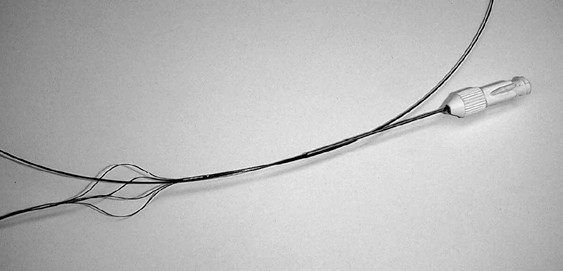Part of what makes nitinol invaluable is its ability to return to its original structure and shape once a stress is removed, all without substantial deformation. This remarkable characteristic stems from nitinol’s reversible solid-state phase transformation, known as martensitic transformation. Nitinol is also highly biocompatibile, resisting corrosion in the human body, and has been proven safe in vascular, soft tissue and orthopedic applications.
The superelastic behavior of nitinol offers a wide range of benefits when compared with stainless steel hypotube. The main advantages can be listed as follows:
- Kink and crush resistance
- Flexibility
- Large amount of recoverable deformation
- Generation of constant or low forces over a wide range of deformation
- Energy storage and restoration
These characteristics have made nitinol a material of choice in a large number of medical devices:
Guidewire or catheter shafts
In that case, nitinol is used for its kink resistance and ‘soft’ end-user feel therefore allowing precise placement and delivery through very tortuous paths without losing a good torqueability and pushability of the device.
The tubing lumen can be used as a method of delivering a diagnostic or therapeutic media to a localized site or as a carrier for another device (drug delivery catheter, needles, biopsy devices, laser or optical fiber guides, other guidewires, etc), as an inflation lumen (for an occluding or expanding balloon such as those used in percutaneous transluminal angioplasty for example)

Surgical instruments
In surgical endoscopic procedures, the very large amount of recoverable deformation is primarily the key characteristics seeked in these types of applications. Usually shape-set superelastic nitinol components are constrained under a very high mechanical strain (up to 6-8%) pending insertion in the patient body cavity though narrow cannulae, trocar ports or percutaneous needles where they are deployed and recover completely or in controlled fashion to their original shape.
Such superelastic recovery allows the deployment, steering, bending, twisting, etc of the distal end of the device and the tube lumen can be used as the carrier for an internal actuation member (a cable that would actuate scissors blades, jaws, etc. for example), a guiding member for another device, a delivery port for a drug or other media.
The flexibility of nitinol tubing has been used in orthopedic bone reamer application, arthroscopic guides, flexible protections for delicate optical or laser-delivery fibers, needles, biopsy devices, etc.
Stents and laser-cut structures
One of the current largest applications for nitinol tubing is for the intraluminal stenting of blood vessels and other ducts.
Although competing tubular wire-frame stents are available, most stent designs dictates the use of tubing as starting material. Superelastic nitinol tubing is increasingly employed in self-expanding design as it offers a much greater resilience and recovery to external pressures which can be deemed critical in some applications like carotid stenting or when arteries are very superficial or going through extensive bending and other mechanical stresses (joint articulations, etc) due to body motions.
Nitinol stents are most commonly laser cut in the constrained condition (delivery size) and then heat treated (shape-set) to their expanded diameters. Post processing include electrochemical or mechanical finishing in order to maximize hemodynamic conditions, enhance fatigue and corrosion resistance, minimize clotting and cell proliferation. The stents are deployed and allowed to self- expand in the vessels via percutaneous catherization. The deployed stent is prevented to completely recover its original shape (very slight oversize compared to vessel diameter) and exerts a very gentle outside pressure against the vessel wall to keep it open and minimize its recoil. The low modulus of superelastic nitinol along with its low unloading plateau stress (adjusted by the thermo- mechanical processing of the material) are among the key mechanical characteristics desired in such applications. It is believed that self-expanding superelastic nitinol stents will play a key role in the safe and less invasive or intraluminal treatment of carotid, aortic and other peripheral vessel disease. It is also foreseen that due to the catheter miniaturization that the material allows, further stent developments and applications will tackle very small distal and inter-cranial lesions.
Since the inception of this technology 10 years ago, the processing and availability of superelastic nitinol tubing have drastically increased allowing its use across a wide variety of medical device
From catheters to self-expanding stents, from guidewires to orthopedic and other devices, superelastic tubing has become a key element in an engineer’s toolbox when a working lumen must be combined with a very high level of elastic shape recovery, kink resistance, low modulus and force generation are required.
The material is ideally suited for medical device applications due to its exceptional superelastic behavior at or near body temperature and has challenged the long established stainless steel hypotubing in many critical cases.
If you need any assistance, please contact us.

